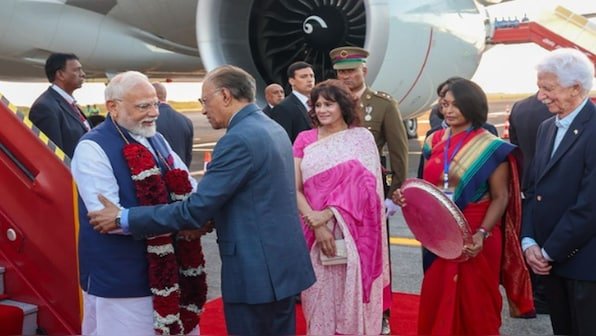
Prime Minister Narendra Modi is in Mauritius today (11 March).
Modi’s two-day visit, on 11 and 12 March, comes in the backdrop of the island nation’s national day celebrations.
Modi, who is travelling to Mauritius at the invitation of Prime Minister Navin Ramgoolam, is set to be the chief guest during the festivities.
Before leaving for Mauritius, Modi said that his visit would open a “new and bright” chapter in the ties between the two nations.
Modi will call on the president of Mauritius, meet the prime minister, and hold meetings with senior dignitaries and leaders of political parties in the island nation. He will also interact with the members of the Indian community, and inaugurate the civil service college and the area health centre, both built with India’s grant assistance.
Modi in a statement said, “Mauritius is a close maritime neighbour, a key partner in the Indian Ocean, and a gateway to the African Continent. We are connected by history, geography and culture. Deep mutual trust, a shared belief in the values of democracy, and celebration of our diversity are our strengths.”
“I look forward to the opportunity to engage the Mauritius leadership to elevate our partnership in all its facets and strength our enduring friendship for the progress and prosperity of our peoples, as well as for security and development in the Indian Ocean Region, as part of our Vision SAGAR. I am confident that this visit will build on the foundations of the past and open a new and bright chapter in the India and Mauritius relationship,” Modi added.
As per lexpress.mu, the seeds of the conflict were first planted nearly a decade earlier – in 1974.
At the time, India and Mauritius reached a defence agreement.
Under this new agreement, India replaced the UK as a guarantor of Mauritius’ security.
This led to massive cooperation between the security services of the two nations.
However, by 1983, the situation had changed completely.
In 1982, the Mauritian Militant Movement-Mauritian Socialist Party (MMM-PSM) coalition had inflicted a heavy defeat on the Labour Party led by Seewoosagur Ramgoolam – which had long been backed by India.
But then the coalition fragmented into two – with by Paul Bérenger heading up the MMM and Prime Minister Anerood Jugnauth on the other with his new MSM party.
“The local political context just imploded as the MMM broke up,” Vijay Makhan, ex-Mauritius foreign secretary, told the outlet.
As per The Diplomat, Bérenger, who had been part of Jugnauth cabinet, was a pro-Soviet radical.
Some in New Delhi were worried about Bérenger and the MMM’s support for Muammar Gaddafi in Libya – who was financing the conversion of Mauritian Hindus to Islam.
They were also worried that Bérenger would “favour the Creole and Muslim minorities and potential provoke a refugee exodus by Hindus.”
According to lexpress.mu, Jugnauth began talking about a possible takeover by MMM and Berenger.
“There were fears and speculation that the MMM might just hatch a coup d’état,” Makhan added. “So the MSM started approaching the Indians.”
Jugnauth, meanwhile, went to New Delhi in February 1983 to rally support from then Indian prime minister Indira Gandhi.
Indira told Jugnauth the Indian Air Force could be in Mauritius by five hours.
As a political observer explained to lexpress.mu about India’s interest in the region, “At that time, Mauritius and India already had bilateral relations, economic and political among others. And India and the United States had a lot of interest in the Indian Ocean. Indira Gandhi was also afraid that the MMM would win these early general elections because it was important for India at that time that the Prime Minister should be of Indian origin.”
The plan
As per The Diplomat, the plan approved by Indira directed troops from the 54th battalion of the Indian Army to help Jugnauth if the MMM-led Bérenger attempted a coup.
India planned to deploy six destroyers with Alouette helicopters and MK 42C Sea Kings.
Then Indian Prime Minister Indira Gandhi had ordered the Indian Army and navy to work together to land troops in Port Louis in case of a coup. PTI
Indira had ordered the Indian Army and navy to work together to land troops in Port Louis, the country’s capital, in case of a coup.
However, the operation was aborted after the leaders of the Indian Army and navy could not work together.
The leaders were at loggerheads over who would lead the operation.
As per lexpress.mu, the 54th battalion, meanwhile, marched to Mumbai without informing the Indian Navy.
The battalion attempted to board the INS Mysore.
However, the plan was shelved after someone leaked it to the US embassy.
Indira instead decided to go with an intelligence operation led by the Research and Analysis Wing’s then chief Nowsher F Suntook.
According to lexpress.mu, Suntook went to Port Louis and worked with then Indian High Commissioner Prem Singh to help stich together an alliance against the MMM.
Suntook and Singh’s efforts paid off – the MSM emerged victorious in the 1983 elections.
Content retrieved from: https://www.firstpost.com/explainers/pm-modi-mauritius-operation-lal-dora-indian-troops-almost-landed-13870423.html.




